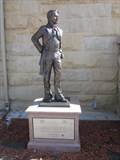From Whom Gilroy Gets Its Name
Gilroy is named for California’s first non-Spanish permanent settler, John Gilroy.
The Scottish seaman from Inverness was actually born John Cameron. Gilroy was his mother’s maiden name, which he substituted for Cameron presumably to avoid detection.
The History of Santa Clara County published in 1881 by Alley, Bowen & Co. of San Francisco describes Gilroy as “six feet in his stockings, as straight as an arrow, broad in the shoulders, a well-proportioned frame, with a keen eye, wide forehead, and lowering brow.
“He was gifted with considerable intelligence and, though not having the advantage of an early scholastic training, became in the days of his manhood an excellent mathematician.”
Gilroy, a Captain’s coxswain, came to Monterey in 1813, 1814 or 1815, depending on the account read. He served on the Isaac Todd, an armed merchant ship commissioned during the War of 1812 and charged with seizing Fort Astoria, an American trading post near the mouth of the Columbia River.
Again, depending on the account, Gilroy was either put ashore to recover from scurvy or jumped ship, depending on the account.
The History tells the story this way:
“When on duty at that port (Monterey) receiving an order from a subordinate commissioned officer which he failed to carry out, he was reprimanded by the midshipman.
“Gilroy’s passion getting the better of his discretion, he struck his superior, thus committing the most unpardonable breach of discipline. He knew that for this offense there could be no exculpation, therefore, arrangements being perfected, he was judiciously entered as sick and with a fellow-sailor sent ashore to recuperate and await the turn of affairs.
“When in sick quarters he concocted a plan for escape, and took into his confidence a comrade, who was afterwards known by the name of ‘Deaf Jimmy.’
“Leaving the hospital they lay perdu* in Monterey for several days, when the vessel sailed without them trusting to find them at some future time.”
Gilroy was baptized at the mission at Carmel in 1817 and became Juan Bautista Gilroy. He became a barrel maker for Ignacio Ortega at Rancho San Ysidro, one of the principal land grants in the area.
In 1821, Gilroy married Ortega’s daughter, Clara, at Mission San Juan Bautista. They had 17 children of whom nine survived.
Upon the father’s death, Gilroy became half owner of the property.
Continues The History:
“He served for many years as alcalde of the district in which he resided, and was chosen a Justice of the Peace by Commodore (Robert) Stockton in the troublous times of 1846, which (Gilroy’s) long residence among the natives fitted him for.”
But things ended badly for Gilroy. He had “one besetting sin,” as The History calls it: Gambling.
 His downfall came from monte, a card game of Spanish origin in which the dealer acts as bank and players bet that a card turned over by the dealer will match the suit of either two or four cards already placed face-up.
His downfall came from monte, a card game of Spanish origin in which the dealer acts as bank and players bet that a card turned over by the dealer will match the suit of either two or four cards already placed face-up.
“Thus did this stalwart Scot fritter away his lands, his herds and, at last, his reputation, to meet his gambling debts, until nothing was left to him but death,” according to The History.
“Towards his last years he was in absolute want. Such was his poverty that he made application (for assistance) to the Society of California Pioneers at San Francisco (on) February 10, 1865, which was refused, it is said on account of his not being a member of that association,” says The History.
“But thanks to the British Benevolent society of that city, his old age received that modicum of comfort refused by the other institution. In 1868, he was bed-ridden from rheumatism. He died in July, 1869, aged about 76 years.”
Much of The History’s telling of Gilroy’s life comes from Julius Martin, a member of the Martin family, which came to Gilroy in 1843, becoming the first Americans to settle there.
The City if Gilroy says it was incorporated during John Gilroy’s lifetime in 1867 — 17 years after becoming a stagecoach stop on the way to San Jose from Monterey. Other sources say incorporation came in 1870, the year following Gilroy’s death.
*(Perdu — “Hidden or concealed.”)
-30-
Filed under: California History
Capitol Cliches Conversational Currency Great Moments in Capitol History News Budget and Economy California History Demographics Fundraising Governor Legislature/Legislation Politics State Agencies
Opinionation Overheard Today's Latin Lesson
Restaurant Raconteur Spotlight Trip to Tokyo Venting Warren Buffett Welcome Words That Aren't Heard in Committee Enough


No comments yet.
RSS feed for comments on this post.